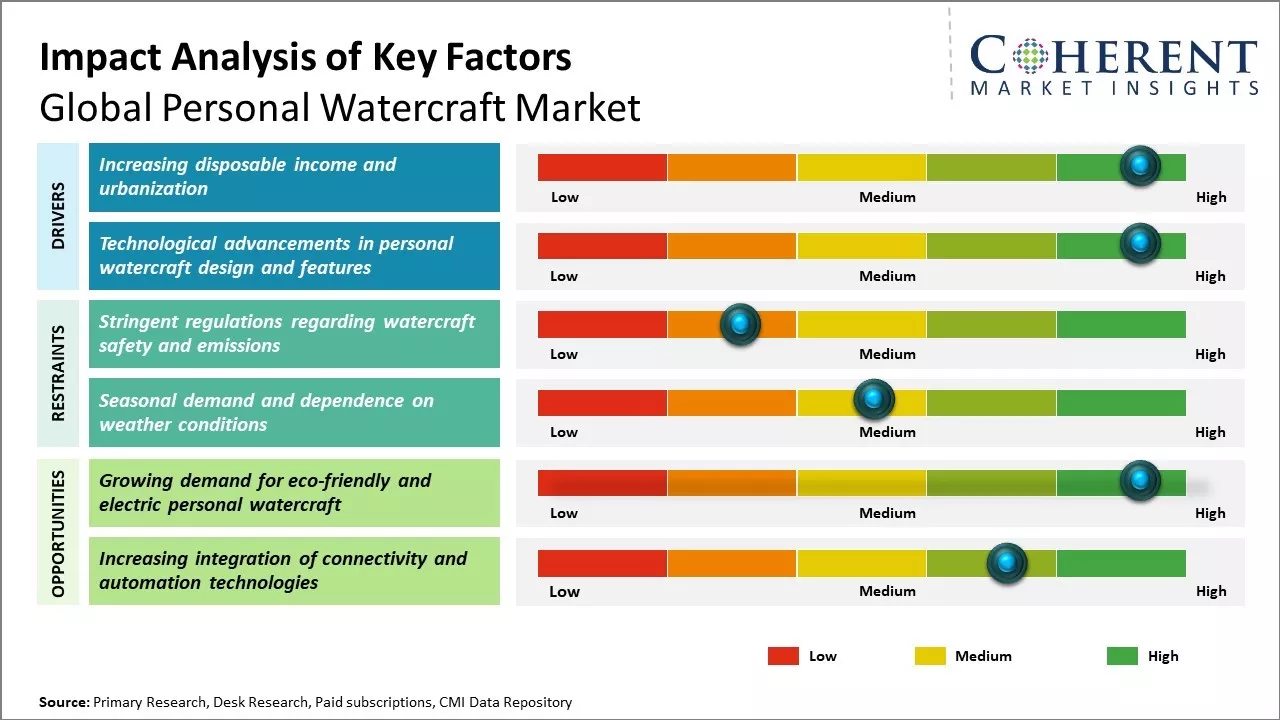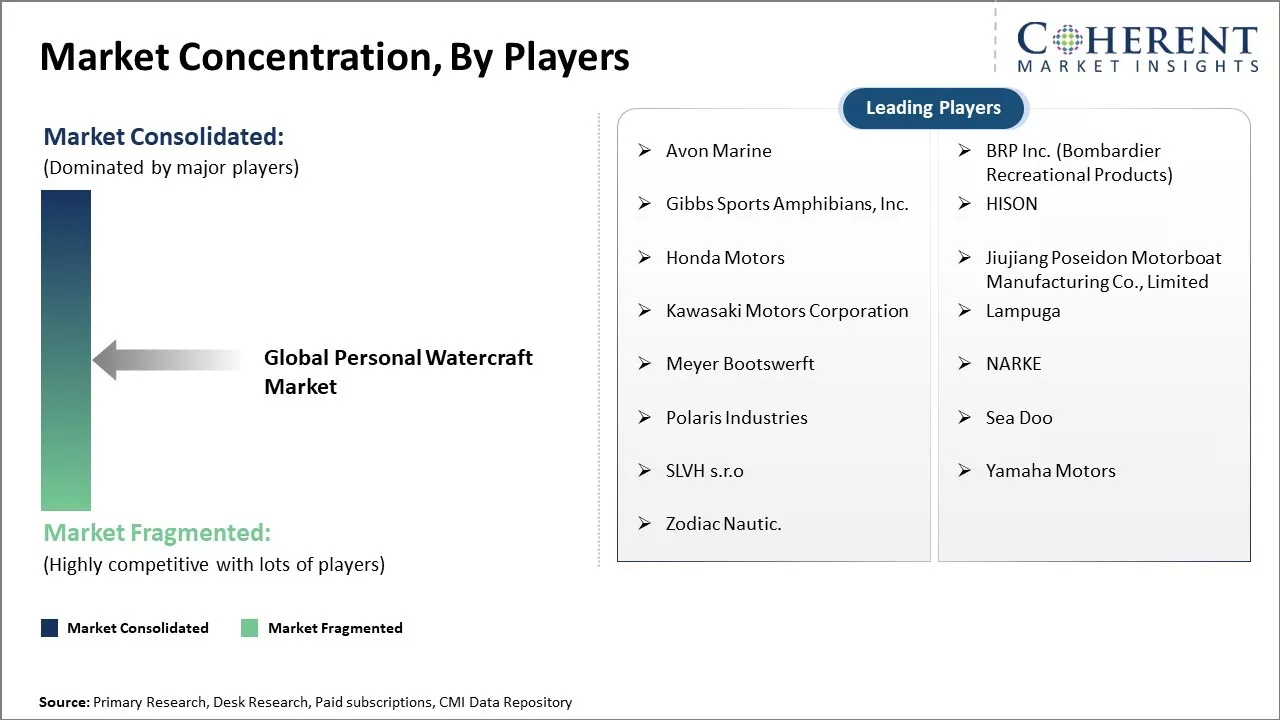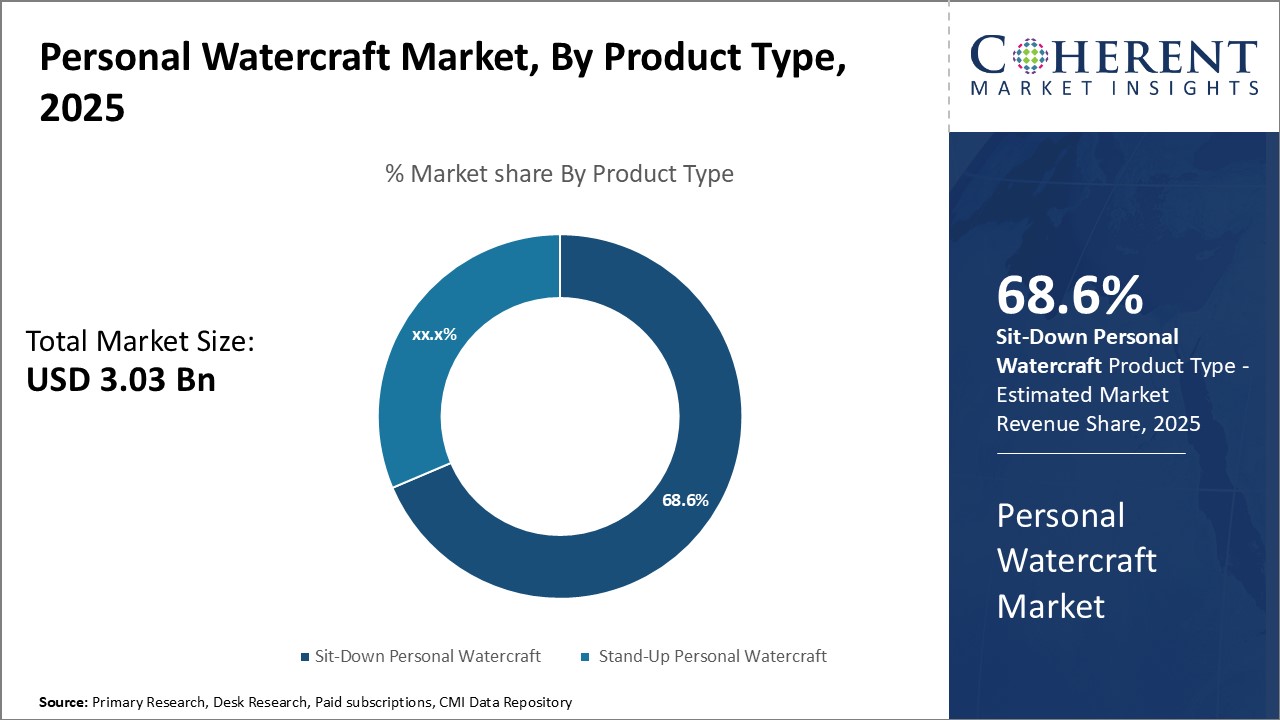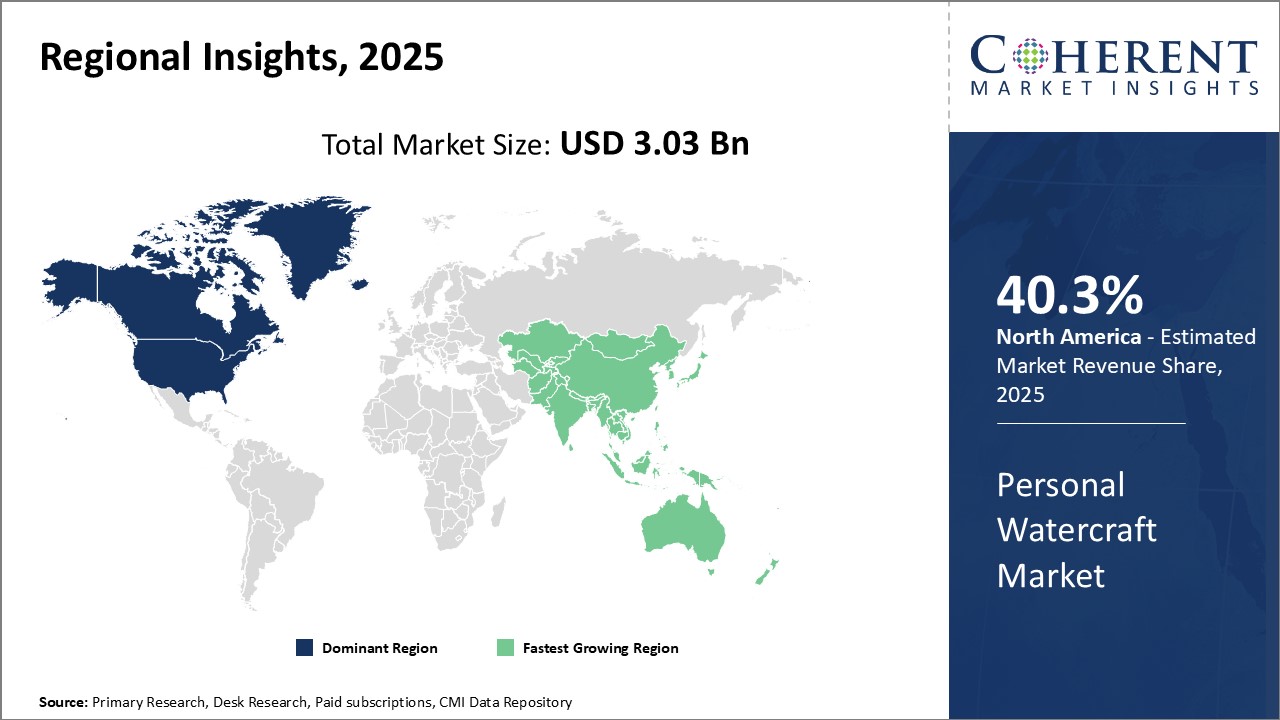Personal Watercraft Market Size and Trends
Global personal watercraft market is estimated to be valued at USD 3.03 billion in 2025 and is expected to reach USD 4.83 billion by 2032, exhibiting a compound annual growth rate (CAGR) of 6.9% from 2025 to 2032.

Discover market dynamics shaping the industry: Download Free Sample
Rising popularity of adventure sports and water activities among youth can boost demand for personal watercrafts in the recreational industry.
The Global personal watercraft market growth is driven by increasing consumer preference for personal watercrafts over motorboats due to their flexibility of use in both shallow and deep waters. Furthermore, technological advancements in personal watercraft design including enhanced features and performance attracts newer customers, thus, driving the market growth.
Increasing disposable income and urbanization
With rapid economic growth and rising affluence in developing nations like China, U.S., Canada, etc., there has been increase in disposable income of individuals. This allows more people to spend money on leisure and recreational activities. Personal watercrafts provide an enjoyable experience of riding on water at high speed, which attracts enthusiasts who are looking for thrill and adventure. Urbanization can also drive the market growth as more young population moves to cities and takes up water-based activities. Cities located near coastlines, beaches or lakes witness huge demand as personal watercrafts allow their users to explore new areas and socialize with friends. The convenient feature of towing tubes or wake skates to pull riders is very popular among city dwellers. Countries with vibrant economies in Asia Pacific and Middle East regions have emerged as key markets propelling global demand for personal watercraft. While initial costs may be high, lower maintenance compared to boats encourages first-time owners especially in developing nations. Personal watercraft ownership is viewed as a status symbol by many people, which is further stimulated by rising living standards. Social media also plays a role where people share their riding experiences catalyzing demand among peer groups. These social and economic trends show no signs of abating, thus, supporting strong prospects for personal watercraft industry.
Market Concentration and Competitive Landscape

Get actionable strategies to beat competition: Download Free Sample
Technological advancements in personal watercraft design and features
Manufacturers are increasingly prioritizing product innovation to attract more customers. They are launching personal watercraft equipped with the latest technological features and design elements to enhance the riding experience. Engine technology has advanced significantly, with some premium models now offering fuel-efficient and powerful engines that rival high-end speedboats. The introduction of smarter ride modes facilitates easier operation for beginners. Additionally, advanced buoyancy aids and ballistic modules provide improved control, even for novice riders. Digital dashboard panels featuring GPS, media playback, and smartphone connectivity have become standard.
The extensive use of lightweight composites reduces weight, allowing for more agile handling and an improved power-to-weight ratio. Comfort is also a key focus, with some models featuring spacious saddles, adjustable backrests, and ample storage capacity. Manufacturers are offering personalization options, including color schemes, graphic designs, and accessory packs. The rising demand for recreational personal watercraft presents opportunities for advanced models with features like floating speakers, cooler boxes, and boarding platforms. Although higher-spec models come at a significant cost, these technological enhancements are likely to attract more customers interested in enjoying water rides with the latest conveniences, driving steady industry expansion.
For instance, In August 2023, BRP, a prominent player in the powersports industry, unveiled its latest lineup of Sea-Doo personal watercraft models, which incorporate advanced design and cutting-edge technology to enhance the riding experience. These new models focus on eco-friendliness and performance, responding to the increasing demand for sustainable watercraft options.
Key Takeaways from Analyst:
Global personal watercraft market growth is driven by rising incomes and disposable incomes globally especially among high-net worth individuals. Declining personal watercraft prices and availability of easy financing options can also boost adoption of personal watercraft. North America currently dominates the personal watercraft market, led by the U.S. However, Asia Pacific region is predicted to be the fastest growing market with countries like China and Japan expected to witness higher sales.
While favorable demographic and economic trends drive the market growth, high maintenance and insurance costs associated with personal watercraft could hamper sales. Strict environmental laws limiting the use of personal watercraft in sensitive marine ecosystems can also hamper the market growth. However, improving technologies that reduce noise and emissions from engines as well as developments that enhance ride quality and safety could help mitigate some concerns.
Manufacturers should focus on expanding into emerging markets and increasing consumer awareness through promotional campaigns. There also exists an opportunity to leverage the rise of recreational boating for fishing, cruising among others. Strategic partnerships with marina operators and retailers that provide rental services can further offer market growth opportunities. With increasing participation in watersports, personal watercraft market will witness growth, if restraints are addressed adequately.
Market Challenge - Stringent regulations regarding watercraft safety and emissions
Global personal watercraft market faces stringent regulations imposed by various environmental agencies and authorities regarding safety and emissions. Many countries and states have mandated safety features like operator alerts, proximity alarms and GPS trackers for all new units sold. Emission norms are also being tightened globally in line with efforts to reduce air and water pollution. Meeting these regulatory guidelines require extensive R&D and compliance testing by manufacturers, significantly raising costs. The enforcement of such laws without a transition period has also slowed down fleet renewals, affecting sales. Many small builders who cannot bear these costs are shutting down operations. Stronger oversight can pose technical and financial challenges to industry players.
Market Opportunity: Growing demand for eco-friendly and electric personal watercraft
As environmental awareness and sustainability become increasingly important, the demand for eco-friendly personal watercraft options is on the rise. Manufacturers are seeing a significant interest in electric models that produce zero direct emissions. Although battery technology has primarily limited electric watercraft to low horsepower models, rapid advancements are quickly bridging this gap. Lithium batteries are becoming denser, offering higher energy capacity at lower costs, which enhances the range and performance of electric personal watercraft (PWCs). Both established manufacturers and new entrants are actively investing in this segment. If technological breakthroughs are achieved and prices become competitive, electric personal watercraft could soon achieve mainstream acceptance, leading to a surge in demand in the coming years.

Discover high revenue pocket segments and roadmap to it: Download Free Sample
Insights By Product Type- Comfort and stability boosts demand for sit-down personal watercraft
In terms of product type, sit-down personal watercraft segment is estimated to contribute the highest market share of 68.6% in 2025, owing to their comfortable riding position and stability in the water. Sit-down personal watercraft have evolved to provide riders with lounge-like seating that allows for longer recreational rides while still experiencing the thrill of speed and maneuverability on the water. The seated position provides better weight distribution and a lower center of gravity for more controlled riding. This makes sit-down watercraft attractive for a variety of riders, from beginners to experienced users. Many models feature additional amenities like storage compartments, speakers, and handholds that further enhance the riding experience.
The comfortable ergonomics of sit-down watercraft allow riders of different physiques and abilities to confidently operate them. The seated position reduces fatigue on longer rides when compared to stand-up models. This broadens the potential customer base to include families with children, older riders, and those with back or leg issues. Many manufacturers have responded by offering three-person capacity on some sit-down watercraft models, expanding their appeal for group recreation. Accessories like padded backs and adjustable seats also cater to varied body types.
The stability offered by sit-down watercraft encourages more daring maneuvers at higher speeds. Their wave-cutting hull designs, wide body shapes, and low center of mass provide exceptional control.
Seating position, ergonomic comfort, inclusive design, and ride control have made sit-down personal watercraft the top choice in terms of product type. Their versatility appeals to a range of demographic and experience levels. Continuous innovation keeps riders engaged with new seating configurations, onboard technologies, and customization options.
Insights By Engine Type- Fuel efficiency and emissions drive four-stroke engine popularity
In terms of engine type, four-stroke engines segment estimated to contribute the highest market share of 74% in 2025, due to their fuel efficiency and reduced emissions over two-stroke counterparts. As environmental regulations have tightened and operating costs have risen, four-stroke engines have gained widespread popularity in the personal watercraft industry.
Compared to two-stroke engines, four-stroke designs provide a more fuel-efficient power source for riding. These achieve better fuel mileage per tank, which is especially valuable for performance enthusiasts who frequently ride at higher speeds. Reduced time spent refueling or making fuel stops also improves the overall time spent riding versus maintaining the watercraft. Lower fuel consumption directly cuts operating expenses for owners over the long-term.
Significantly, four-stroke engines emit fewer pollutants due to their closed combustion system relative to two-stroke open port designs. Tougher emission standards have effectively displaced two-stroke models from many global markets. Four-stroke watercraft meet regulations while still satisfying demand for power and performance. Many personal watercraft are now marketed based on their clean burning credentials.
Insights By Application - Adrenaline and convenience drive recreational personal watercraft usage
In terms of application, recreational segment is estimated to contribute the highest market share of 51.9% in 2025, owing to adrenaline rush and flexibility it provides to users. Whether tearing across waves, jumping wakes, or spraying friends, recreational use delivers an unparalleled burst of adrenaline. Personal watercraft are exhilarating performer vehicles designed specifically for maximizing this kind of unconstrained fun.
Manufacturers have responded with even more powerful engine options that achieve new heights of acceleration and top speeds. Features like enhanced ergonomics and customizable control interfaces also improve the riding experience. Upgrades in safety systems allow for pushing limits with less risk. Riders are constantly engaging with manufacturers online to discover the latest innovations unlocking yet more thrills.
Beyond straight adrenaline, personal watercraft are highly practical recreational tools. These take advantage of natural resources like lakes, rivers, and coastlines for diverse activities. Riders enjoy tow sports, cruising, or simply soaking in scenic surroundings quickly and easily. Personal watercraft can be trailered and deployed virtually anywhere there is water access. Their portability makes packing up and continuing the fun at a new location hassle-free.
The thrills of open water riding and flexibility of personal watercraft drive recreational application segment. These perfectly fulfill demand for fun, adventure, and quality time spent on the water with family and friends.
Regional Insights

Need a Different Region or Segment? Download Free Sample
North America dominates the personal watercraft market with an estimated market share of 40.3% in 2025, due to its strong recreational boating culture. The U.S. represents the largest market globally with the highest penetration of watercraft ownership per capita due to the extensive coastlines across many American states and the presence of large inland waterways and lakes that are perfect for recreational activities like water sports. Many leading manufacturers also have their headquarters and major production facilities located in the U.S., allowing them to closely understand customer needs and rapidly respond to market changes in the region.
Asia Pacific region is estimated to be the fastest growing region. Countries like Australia and Japan have shown steady expansion over the past decade due to rising incomes and interest in leisure boating. However, more recently new emerging markets like China and India are displaying the fastest growth rates globally. This is largely being fueled by rapidly growing middle-class populations that now have greater disposable incomes to spend on recreational activities. Improved infrastructure and the development of coastal tourist destinations in these countries have increased access to waterways. Local governments also recognize water sports as a profitable industry and are actively promoting participation through initiatives and events.
Manufacturers are strategically responding to opportunities in Asia Pacific by establishing new local production plants, expanding dealership networks, and tailoring product offerings to consumer preferences in different markets. For example, smaller engine sizes suitable for inland use are popular in China. The region’s proximity to major manufacturing hubs allows companies to leverage relatively lower costs for parts sourcing and assembly. With continued economic development and rising interest in boating lifestyles, Asia Pacific shows enormous potential of becoming the next major growth engine in the global personal watercraft industry.
Market Report Scope
Personal Watercraft Market Report Coverage
| Report Coverage | Details | ||
|---|---|---|---|
| Base Year: | 2024 | Market Size in 2025: | USD 3.03 Bn |
| Historical Data for: | 2020 To 2024 | Forecast Period: | 2025 To 2032 |
| Forecast Period 2025 to 2032 CAGR: | 6.9% | 2032 Value Projection: | USD 4.83 Bn |
| Geographies covered: |
|
||
| Segments covered: |
|
||
| Companies covered: |
Avon Marine, BRP Inc. (Bombardier Recreational Products), Gibbs Sports Amphibians, Inc., HISON, Honda Motors, Jiujiang Poseidon Motorboat Manufacturing Co., Limited, Kawasaki Motors Corporation, Lampuga, Meyer Bootswerft, NARKE, Polaris Industries, Sea Doo, SLVH s.r.o, Yamaha Motors, and Zodiac Nautic. |
||
| Growth Drivers: |
|
||
| Restraints & Challenges: |
|
||
Uncover macros and micros vetted on 75+ parameters: Get instant access to report
Personal Watercraft Industry News
- In January 2024, Searider, a Monaco-based startup focusing on innovative marine solutions, launched its all-electric personal watercrafts, the Searacer and Seacruiser. These zero-emission watercrafts are inspired by motorcycle and Vespa-style designs, showcasing a modern aesthetic and commitment to sustainability.
- In June 2023, Float On, an Austin-based boat rental company, established itself as an official Taiga Service Provider (TSP), enabling Taiga to introduce sustainable water exploration to the state of Texas
- In August 2023, Yamaha Watercraft Group, a prominent manufacturer of personal watercraft, launched its new ‘four-stroke SuperJet’, a personal watercraft featuring advanced capabilities. This revamped model is designed to deliver enhanced performance and stability for riders.
- In May 2023, BRP Inc. (Bombardier Recreational Products), a global leader in powersports products, received recognition for design and innovation in its Sea-Doo lineup. This acknowledgment enhances consumer trust and attracts new customers, reflecting the company's commitment to excellence in the personal watercraft market.
- In February 2023, Kawasaki Motors, Ltd., a leading manufacturer of motorcycles and personal watercraft, launched its 2023 series of jet skis, including the Jet Ski Ultra 160LX and Jet Ski Ultra 160LX-S. These models are equipped with features such as smart reverse, accent lights, a rearview camera, easy access storage and pockets, and integrated audio systems, all designed to enhance performance, comfort, and luxury styling.
*Definition: The personal watercraft market consists of small, powered watercraft designed for recreational use by one or more riders. Personal watercraft, also known as water scooters or jet skis, provide riders a fun and thrilling experience gliding across bodies of water at high speeds. Top manufacturers in this market offer a variety of personal watercraft models that vary in passenger capacity, engine power, and watercraft size to suit different budgets and rider preferences. Popular brands include Sea-Doo, Yamaha, Kawasaki, etc.
Market Segmentation
- By Product Type Insights (Revenue, USD Bn, 2020 - 2032)
-
- Sit-Down Personal Watercraft
- Stand-Up Personal Watercraft
- By Engine Type Insights (Revenue, USD Bn, 2020 - 2032)
-
- Four-Stroke Engines
- Two-Stroke Engines
- By Application Insights (Revenue, USD Bn, 2020 - 2032)
-
- Recreational
- Racing
- Touring
- Others
- Regional Insights (Revenue, USD Bn, 2020 - 2032)
- North America
- U.S.
- Canada
- Latin America
- Brazil
- Argentina
- Mexico
- Rest of Latin America
- Europe
- Germany
- U.K.
- Spain
- France
- Italy
- Russia
- Rest of Europe
- Asia Pacific
- China
- India
- Japan
- Australia
- South Korea
- ASEAN
- Rest of Asia Pacific
- Middle East
- GCC Countries
- Israel
- Rest of Middle East
- Africa
- South Africa
- North Africa
- Central Africa
- North America
- Key Players Insights
-
- Avon Marine
- BRP Inc. (Bombardier Recreational Products)
- Gibbs Sports Amphibians, Inc.
- HISON
- Honda Motors
- Jiujiang Poseidon Motorboat Manufacturing Co., Limited
- Kawasaki Motors Corporation
- Lampuga
- Meyer Bootswerft
- NARKE
- Polaris Industries
- Sea Doo
- SLVH s.r.o
- Yamaha Motors
- Zodiac Nautic.
Share
Share
About Author
Ameya Thakkar is a seasoned management consultant with 9+ years of experience optimizing operations and driving growth for companies in the automotive and transportation sector. As a senior consultant at CMI, Ameya has led strategic initiatives that have delivered over $50M in cost savings and revenue gains for clients. Ameya specializes in supply chain optimization, process re-engineering, and identification of deep revenue pockets. He has deep expertise in the automotive industry, having worked with major OEMs and suppliers on complex challenges such as supplier analysis, demand analysis, competitive analysis, and Industry 4.0 implementation.
Missing comfort of reading report in your local language? Find your preferred language :
Transform your Strategy with Exclusive Trending Reports :
Frequently Asked Questions
EXISTING CLIENTELE
Joining thousands of companies around the world committed to making the Excellent Business Solutions.
View All Our Clients
